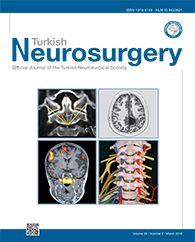2Istanbul University, Cerrahpaşa Faculty of Medicine, Department of Neurosurgery, Istanbul, Turkey
3Memorial Health Group, Neurosurgery Clinic, Istanbul, Turkey DOI : 10.5137/1019-5149.JTN.19177-16.1 AIM: Neurosurgical oncology that is performed for lesions located in critical areas like the sensorimotor area has additional risk because it may cause serious neurological deficiencies. Some intraoperative neuromonitoring (IONM) modalities can effectively help the surgeons to maximize resections of this kind of lesions with or without an acceptable neurological deficiency. Our aim was to share our IONM experiences with patients who underwent intracranial lesion surgery in critical areas between September 2013 and January 2015.
MATERIAL and METHODS: This retrospective study was performed on 31 patients who underwent brain surgery for the resection of lesions located in eloquent areas. Demographic characteristics, lesion localizations, lesion pathologies, surgery, IONM recordings, and pre- and postoperative neurological examinations were reviewed.
RESULTS: Five of the 31 patients had lesions in the cerebellopontine angle and 26 patients had lesions close to critical locations. Transcranial motor evoked potentials and somatosensory evoked potentials were performed in 27, electroencephalography in 31, auditory evoked potentials in 8, visual evoked potentials in 2, triggered electromyography in 8, and central sulcus determination and brain mapping in 17 patients. Motor evoked potential changes occurred in 2 patients intraoperatively. One had right hemiparesia lasting 3 days while the other had monoparesia which improved within 2 months. Permanent neurological deficit was not observed.
CONCLUSION: Intraoperative neuromonitoring helps the surgeons to maximize resection of lesions in or close to eloquent areas of the brain. Using only one modality is not sufficient, whereas a combination of modalities is required to obtain a better outcome.
Keywords : Neurosurgical oncology, Evoked potentials, Multimodality, Intraoperative monitoring




